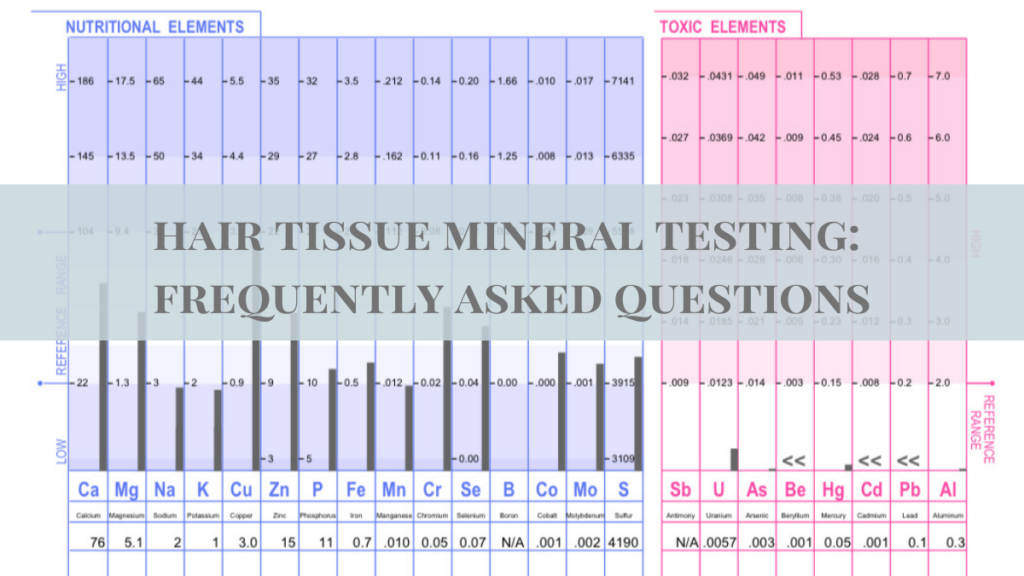
Hair tissue mineral testing was developed in the 1970’s by Dr’s Eck and Watts. I personally became fascinated with hair tissue mineral testing in an effort to address my own health issues. I had all the classic signs of hypothyroid and unfortunately was not getting any answers from bloodwork. My first hair test showed severe imbalances in certain minerals, which pointed to slowed thyroid function and adrenal fatigue. It was a very validating test and I then learned how to address deficiencies and rebalance my minerals.
I now incorporate hair tissue mineral analysis with many of my one on one clients. My training on understanding minerals and and toxic metals was through Root Cause Protocol, under Morley Robbins. I take a root cause focused approach to helping my clients heal and recover their energy so they can get back to doing the things they love the most.
Your hair contains all the minerals present in your body, including nutritional minerals as well as toxic heavy metals. HTMA is a laboratory test that measures the mineral content in the hair. It is a preventative screening tool that helps get to the root cause of many chronic and age related conditions. In most cases, the test results reflect how much of these elements are in your tissues and provide a vivid picture of your internal environment. With this information, a world of metabolic markers can be interpreted. Not only can your nutritional status be viewed, but we can also learn about how efficiently your body is working.
Hair testing has emerged as the most practical method for mineral balance in your body.
It provides a mineral outline, and other information regarding your metabolic rate, energy levels, sugar and carbohydrate tolerance, stage of stress, immune system function and glandular activity such as your adrenals and thyroid.
The test reveals 29 minerals and their ratios plus 8 heavy metals. With the data from an HTMA we can gain a better understanding of heavy metal toxicity, mineral/ nutrient deficiencies, your metabolic rate (fast or slow), adrenal + thyroid function, hormonal imbalances, nervous system imbalances, inflammation, energy levels, mental health, liver function, blood sugar imbalances/ diabetes, digestive dysfunction and if any infections or viruses are present. Click here to review a helpful article on the HTMA.
Blood tests give information about your mineral levels at the time of the test only. If you’ve just eaten a banana, your test can indicate a high potassium level, even though you may be low in potassium. An HTMA gives you your actual mineral storage levels over a period of time. A blood test will only accurately report what is being transported in your blood at the time of the test.
Testing for minerals in the urine measures the minerals that are being excreted from your body – not necessarily what has been absorbed as fuel for your body.
The hair to be collected should be clean and you should not use permed, dyed or bleached hair. The hair should come from several areas of your scalp on the back portion of your head. You simply part the hair and cut as close to the scalp as possible. Cut away excess hair from the sample, leaving about 1 to 1 ½ inches of the root end. The total amount of hair needed is about a tablespoon.
Click here for a youtube tutorial on how to clip your hair for the sample.
Diet: Improper eating habits is a major contributor to mineral imbalances. Excessive intake of refined carbohydrates, alcohol and restrictive diets can all lead to poor mineral nutrition and absorption. Even the mineral content of a “healthy” diet can be inadequate, depending upon the soil in which the food was grown or the method in which it was prepared.
Stress: Physical or emotional / mental stress can lead to mineral imbalances. Certain nutrients such as the minerals magnesium, zinc and the B-complex vitamins are lost in greater quantities due to increased stress. Nutrient absorption can also decrease when the body is under stress.
Medications: Medications can deplete the body store of nutrient minerals or increase the levels of toxic metals. The well-known effects of diuretics include not only sodium loss, but in many cases a loss of potassium, copper and magnesium. Antacids, aspirin, and oral contraceptives / hormonal birth control can lead to vitamin and mineral deficiencies as well as toxic metal excesses.
Pollution: Toxic metals such as lead, mercury and cadmium can interfere with mineral absorption and increase mineral excretion. From adolescence to adulthood the average person is continually exposed to a variety of toxic metal sources such as cigarette smoke (cadmium), copper and aluminum cookware, hair dyes (lead), lead based cosmetics, hydrogenated oils, antiperspirants (aluminum), and dental amalgams (mercury and cadmium). These are just a few of the hundreds of sources an individual may be exposed to every day.
Nutritional supplements: Vitamin and mineral supplements can also lead to mineral imbalances. Calcium absorption is increased in the presence of phosphorus. Vitamin C is required for iron absorption, but in excess amounts it can cause a copper deficiency. Vitamin D enhances calcium absorption, but in excess amounts can produce a magnesium and potassium deficiency.
Minerals are the spark plugs in our body. The exchanges of energy in the combustion of foods and the building of living tissues depend on minerals. “Minerals have interrelationships with every other nutrient. Without optimum mineral levels within the body, the other nutrients are not effectively utilized.” says Dr. Emmanuel Cheraskin, author of the book Diet and Disease.
Minerals are necessary in the production of hormones, enzyme activity and more. If minerals are depleted or out of balance this can impact your menstrual cycle, thyroid health, insulin / glucose metabolism, digestion, lead to calcification of your tissues, headaches, cardiovascular issues and so much more.
Adrenal fatigue / burned out adrenals: The adrenal cortex produces mineralcorticoid hormones. The primary function of these hormones is to regulate electrolytes, sodium and potassium. Hair tissue studies of these two minerals, in conjunction with other minerals and ratios, can give an indication of adrenal activity.
Hyperthyroid or hypothyroid conditions: Thyroid activity is often indicated by the tissue calcium to potassium ratio. Potassium is necessary for sensitizing the tissues to the effects of thyroxine. Elevation of calcium in relation to potassium indicates a trend toward hypothyroidism, while a low tissue calcium to potassium ratio indicates a trend toward hyperthyroidism.
Arteriosclerosis: Excessive calcium deposition on the arteries is higher in areas of the world with magnesium deficient soils and water. Magnesium is required in sufficient amounts to maintain a resistance to excessive calcium in the soft tissues of the body. An abnormal amount of calcium to magnesium relationship can be readily identified through tissue mineral testing. The abornoaml relationship of these minerals is not always revealed by other diagnostic tests.
Hypertension. High sodium intake has long been associated with hypertension. Recent evidence now indicates that other minerals can protect the body from the adverse affects of sedum. Tissue calcium levels in relation to sodium, and magnesium to sodium ratios can show a trend toward high blood pressure as well as indicate protective or control measures through supplement and dietary modifications.
Hyperactivity: Research reveals a strong relationship between hyperactivity in children and toxic metals such as cadmium, lead, and mercury, as well as high levels of iron, manganese and copper.
Migraine headaches. Excessive nutrient mineral accumulation as well as toxic metals such as cadmium, mercury, and lead can contribute to migraine headaches.
Hair testing is a service I offer to one on one clients. Click here to check out my two packages and request to book a free discovery call to learn more information. Once you’re ready to move forward, I give you instructions on how to send your hair sample to lab. The lab sends test results in about 2 weeks after they’ve received your hair. Once we have the test results I will help you interpret your ratios and give you a customized protocol to help you rebalance your minerals. We also evaluate other aspects of your health that can influence your minerals including sleep, nutrition, supplements, exercise habits, stress and more. You can also email me at margaret@margaretpowell.com for more information!
** Information sourced from Trace Elements: Balancing Body Chemistry Guide and The Strands of Health by Dr. Rick Malter.

I'm a Certified Holistic Nutritionist + Holistic Health Coach, Functional Diagnostic Nutritionist and owner of an integrative virtual wellness clinic that has helped hundreds of women on their journey to optimal health.
I know from my own personal health journey that it's possible to reclaim my body after years of struggling. I was confused and overwhelmed, dismissed by health providers who didn't take the time to understand the "why" behind my symptoms. Then I discovered Functional Nutrition and worked through the process of unraveling the root causes behind my struggles, everything changed.
Now I'm here to help you do the same!